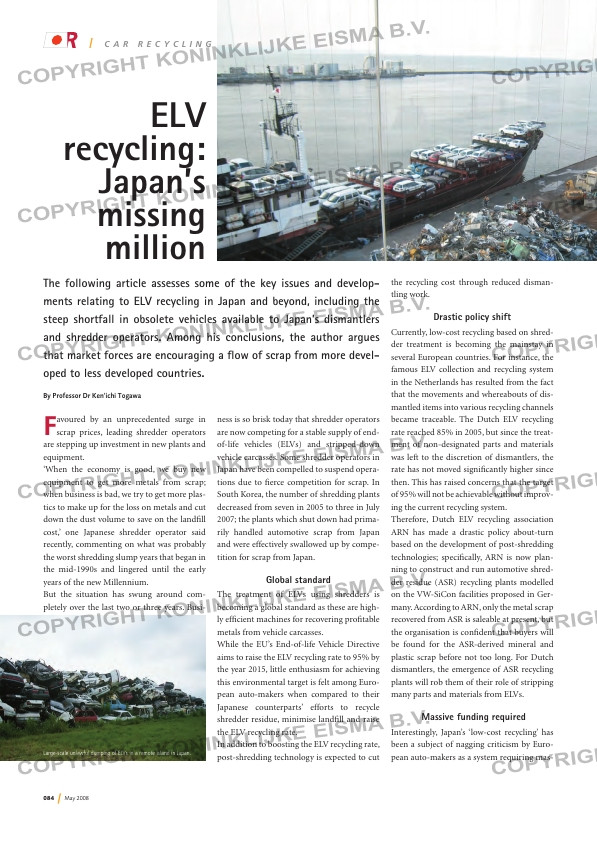Page 84 from: May 2008

084 May 2008
By Professor Dr Ken’ichi Togawa
Favoured by an unprecedented surge in scrap prices, leading shredder operators
are stepping up investment in new plants and
equipment.
‘When the economy is good, we buy new
equipment to get more metals from scrap;
when business is bad, we try to get more plas-
tics to make up for the loss on metals and cut
down the dust volume to save on the landfill
cost,’ one Japanese shredder operator said
recently, commenting on what was probably
the worst shredding slump years that began in
the mid-1990s and lingered until the early
years of the new Millennium.
But the situation has swung around com-
pletely over the last two or three years. Busi-
The following article assesses some of the key issues and develop-
ments relating to ELV recycling in Japan and beyond, including the
steep shortfall in obsolete vehicles available to Japan’s dismantlers
and shredder operators. Among his conclusions, the author argues
that market forces are encouraging a flow of scrap from more devel-
oped to less developed countries.
ness is so brisk today that shredder operators
are now competing for a stable supply of end-
of-life vehicles (ELVs) and stripped-down
vehicle carcasses. Some shredder operators in
Japan have been compelled to suspend opera-
tions due to fierce competition for scrap. In
South Korea, the number of shredding plants
decreased from seven in 2005 to three in July
2007; the plants which shut down had prima-
rily handled automotive scrap from Japan
and were effectively swallowed up by compe-
tition for scrap from Japan.
Global standard
The treatment of ELVs using shredders is
becoming a global standard as these are high-
ly efficient machines for recovering profitable
metals from vehicle carcasses.
While the EU’s End-of-life Vehicle Directive
aims to raise the ELV recycling rate to 95% by
the year 2015, little enthusiasm for achieving
this environmental target is felt among Euro-
pean auto-makers when compared to their
Japanese counterparts’ efforts to recycle
shredder residue, minimise landfill and raise
the ELV recycling rate.
In addition to boosting the ELV recycling rate,
post-shredding technology is expected to cut
the recycling cost through reduced disman-
tling work.
Drastic policy shift
Currently, low-cost recycling based on shred-
der treatment is becoming the mainstay in
several European countries. For instance, the
famous ELV collection and recycling system
in the Netherlands has resulted from the fact
that the movements and whereabouts of dis-
mantled items into various recycling channels
became traceable. The Dutch ELV recycling
rate reached 85% in 2005, but since the treat-
ment of non-designated parts and materials
was left to the discretion of dismantlers, the
rate has not moved significantly higher since
then. This has raised concerns that the target
of 95% will not be achievable without improv-
ing the current recycling system.
Therefore, Dutch ELV recycling association
ARN has made a drastic policy about-turn
based on the development of post-shredding
technologies; specifically, ARN is now plan-
ning to construct and run automotive shred-
der residue (ASR) recycling plants modelled
on the VW-SiCon facilities proposed in Ger-
many. According to ARN, only the metal scrap
recovered from ASR is saleable at present, but
the organisation is confident that buyers will
be found for the ASR-derived mineral and
plastic scrap before not too long. For Dutch
dismantlers, the emergence of ASR recycling
plants will rob them of their role of stripping
many parts and materials from ELVs.
Massive funding required
Interestingly, Japan’s ‘low-cost recycling’ has
been a subject of nagging criticism by Euro-
pean auto-makers as a system requiring mas-
C a r r e C y C l i n g
ELV
recycling:
Japan’s
missing
million
Large-scale unlawful dumping of ELVs in a remote island in Japan.
RI_012_CAR RI_Japan.indd 2 14-05-2008 13:50:31



